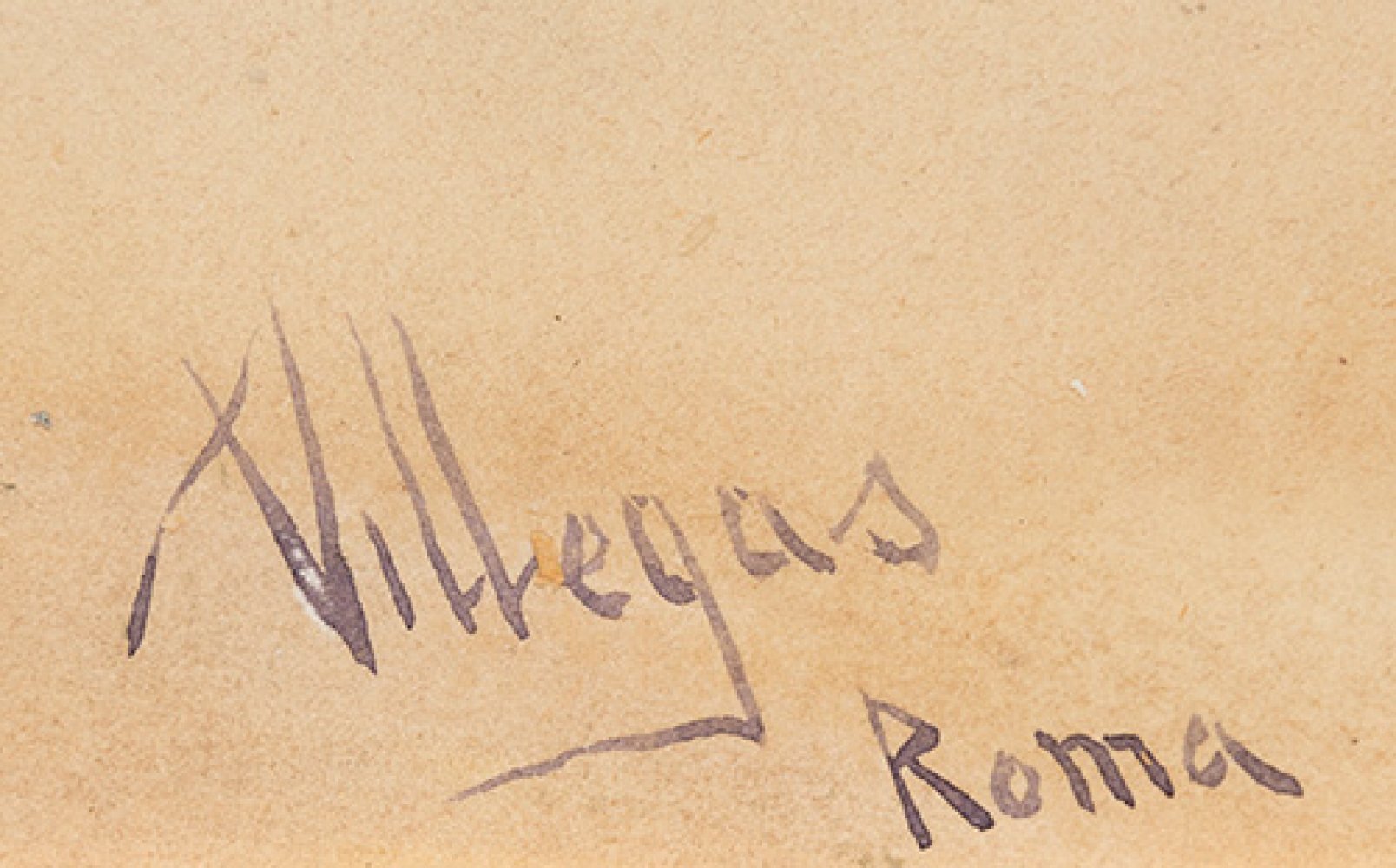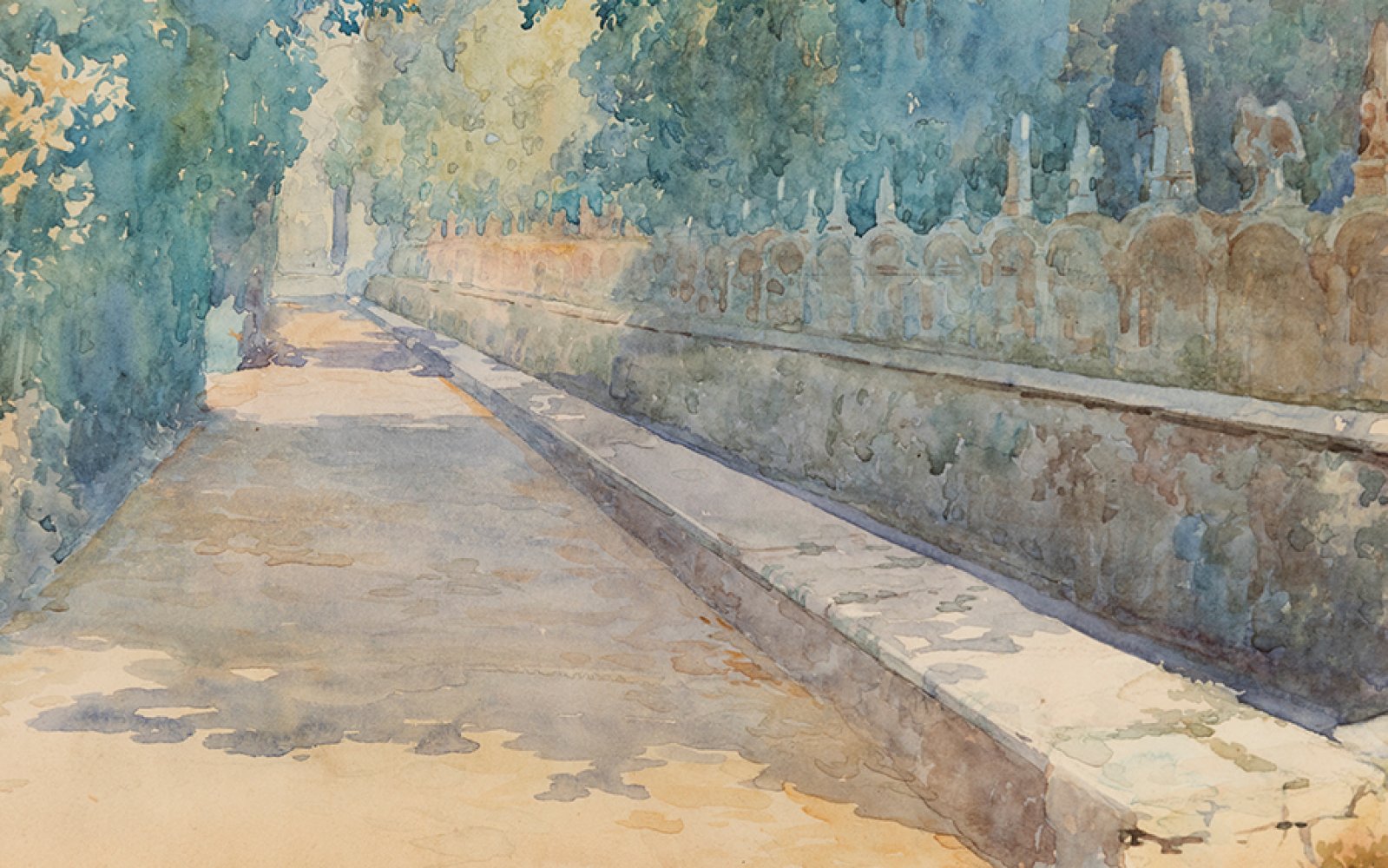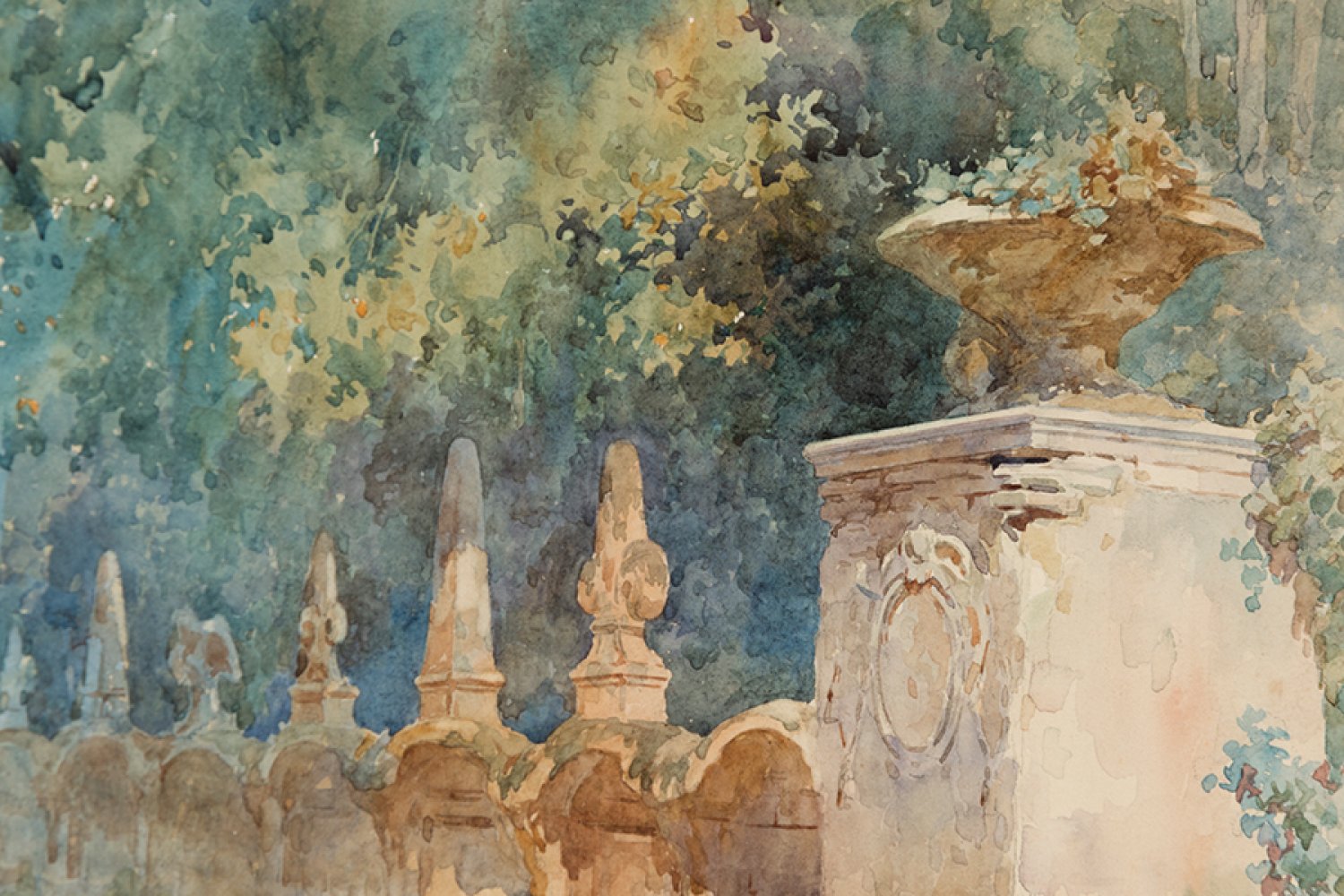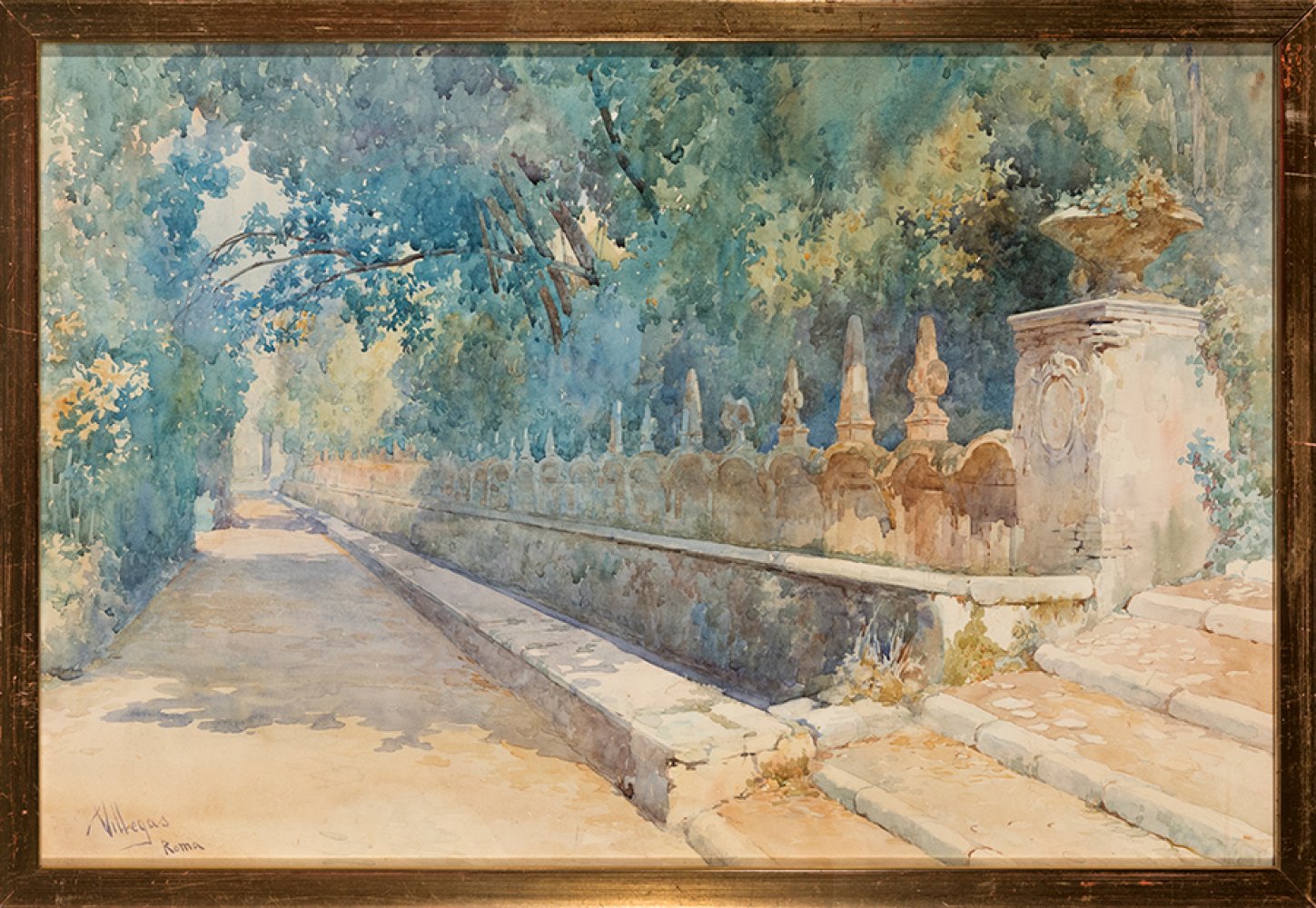28
JOSÉ VILLEGAS CORDERO (Seville, 1848 - Madrid, 1921)."Villa d' Este, the 1000 fountains (Rome)".
"Villa d' Este, the 1000 fountains (Rome)".
Watercolour on paper.
Attached certificate issued by Don Ángel Castro.
Signed and located in the lower left corner.
Measurements: 35 x 53 cm; 38,5 x 57 cm (frame).
The artists of the Spanish colony in Rome, Villegas among them, finding in the gardens of Villa d'Este in Tivoli, one of the favourite places to escape during the summer. in this case the author represents the fountain of the hundred spouts, which he had already painted in a work of the year 1896. although in this case he does not introduce any human presence, but focuses his attention on the landscape.
José Villegas began his apprenticeship with José María Romero, under whose guidance he studied for two years. He then entered the School of Fine Arts, where he was a pupil of Eduardo Cano. At an early age he took his painting "Little Philosopher" to the Seville Exhibition of 1860, which sold for 2,000 reales. Around 1867, still in his formative years, he painted two canvases: "Girls begging for alms", highly praised by the critics, and "Columbus at La Rábida", acquired by the Duke and Duchess of Montpensier. He then travelled to Madrid, where he went to the studio of Federico de Madrazo. There he became friends with Rosales and Fortuny, and studied the masters of the Prado Museum. During this period he copied Velázquez, whose spontaneous style he adopted for his pictorial technique, as well as his vibrant colour. Seduced by Fortuny's orientalist work, Villegas returned to Seville and visited Morocco, from where he brought back some sketches and sketches. At the end of 1868 he decided to move to Rome in the company of Rafael Peralta and Luis Jiménez Aranda. There he attended the evening classes at the Accademia Chigi and shared a studio with other colleagues until he moved to Rosales's studio. At this time his work focused on genre scenes, a genre in which Villegas achieved resounding success, being in constant demand by a clientele eager for traditional themes, especially bullfighters and dancers. His extraordinary versatility also enabled him to satisfy the demand of an international clientele who, after Fortuny, demanded Arab fantasy themes. Thus, Villegas made use of his sketches taken in Morocco, without forgetting genre and "casacones" themes. In the mid-1970s he returned to Seville and visited Morocco again. Back in Rome in 1876, he took up the torch left by Fortuny and became the most admired and sought-after painter among dealers and collectors. He continued to work on his orientalist and costumbrist themes and sent his works to Spanish exhibitions. In 1878, following a commission from the Spanish Senate, Villegas began to work on history themes. In the mid-1980s he also focused on paintings directly inspired by Italian Renaissance art, the culminating work in this style being "The Triumph of the Dogaressa", painted in 1892 and exhibited to great acclaim in Berlin. During these years he worked especially in Venice, a city that offered him an inexhaustible setting for his compositions. In 1898 he was appointed director of the Academy of Fine Arts in Rome, in 1901 director of the Museo del Prado and in 1903 a member of the Academy of San Fernando. He is currently represented in the Prado Museum, the Fine Arts Museums of Seville and Cordoba, the San Telmo Museum in San Sebastián and the Bank of Spain Collection, among other important public and private institutions.
"Villa d' Este, the 1000 fountains (Rome)".
Watercolour on paper.
Attached certificate issued by Don Ángel Castro.
Signed and located in the lower left corner.
Measurements: 35 x 53 cm; 38,5 x 57 cm (frame).
The artists of the Spanish colony in Rome, Villegas among them, finding in the gardens of Villa d'Este in Tivoli, one of the favourite places to escape during the summer. in this case the author represents the fountain of the hundred spouts, which he had already painted in a work of the year 1896. although in this case he does not introduce any human presence, but focuses his attention on the landscape.
José Villegas began his apprenticeship with José María Romero, under whose guidance he studied for two years. He then entered the School of Fine Arts, where he was a pupil of Eduardo Cano. At an early age he took his painting "Little Philosopher" to the Seville Exhibition of 1860, which sold for 2,000 reales. Around 1867, still in his formative years, he painted two canvases: "Girls begging for alms", highly praised by the critics, and "Columbus at La Rábida", acquired by the Duke and Duchess of Montpensier. He then travelled to Madrid, where he went to the studio of Federico de Madrazo. There he became friends with Rosales and Fortuny, and studied the masters of the Prado Museum. During this period he copied Velázquez, whose spontaneous style he adopted for his pictorial technique, as well as his vibrant colour. Seduced by Fortuny's orientalist work, Villegas returned to Seville and visited Morocco, from where he brought back some sketches and sketches. At the end of 1868 he decided to move to Rome in the company of Rafael Peralta and Luis Jiménez Aranda. There he attended the evening classes at the Accademia Chigi and shared a studio with other colleagues until he moved to Rosales's studio. At this time his work focused on genre scenes, a genre in which Villegas achieved resounding success, being in constant demand by a clientele eager for traditional themes, especially bullfighters and dancers. His extraordinary versatility also enabled him to satisfy the demand of an international clientele who, after Fortuny, demanded Arab fantasy themes. Thus, Villegas made use of his sketches taken in Morocco, without forgetting genre and "casacones" themes. In the mid-1970s he returned to Seville and visited Morocco again. Back in Rome in 1876, he took up the torch left by Fortuny and became the most admired and sought-after painter among dealers and collectors. He continued to work on his orientalist and costumbrist themes and sent his works to Spanish exhibitions. In 1878, following a commission from the Spanish Senate, Villegas began to work on history themes. In the mid-1980s he also focused on paintings directly inspired by Italian Renaissance art, the culminating work in this style being "The Triumph of the Dogaressa", painted in 1892 and exhibited to great acclaim in Berlin. During these years he worked especially in Venice, a city that offered him an inexhaustible setting for his compositions. In 1898 he was appointed director of the Academy of Fine Arts in Rome, in 1901 director of the Museo del Prado and in 1903 a member of the Academy of San Fernando. He is currently represented in the Prado Museum, the Fine Arts Museums of Seville and Cordoba, the San Telmo Museum in San Sebastián and the Bank of Spain Collection, among other important public and private institutions.
13th July - 19th and 20th century paintings
Sale Date(s)
Venue Address
General delivery information available from the auctioneer
Setdart offers Worldwide shipping
PICK UP IN ROOM: You can come and pick up your lots in our offices (Barcelona, Madrid or Valencia). At the moment of the withdrawal, you will be able to accept the current conditions of the lot by means of a document that you will sign.
YOU CAN SEND ANOTHER PERSON TO PICK UP: This person must present a signed authorization that you can find in our web page by accessing from BUY AT SETDART- LOGISTICS-DOWNLOAD AUTHORIZATION DOCUMENT. You can also send an e-mail with the requested data in AUTHORIZATION DOCUMENT to admin@setdart.com
Important Information
25% buyer´s premium
21% buyer´s premium at www.setdart.com
Terms & Conditions
The maximum period to pay the lots is 7 working days. You can pay either via bank transfer or with credit card through our platform www.setdart.com (we only accept VISA or Mastercard).
BUYER´S PREMIUM: 22% Hammer price + 21% VAT from the buyer´s premium
If your piece has more than 100 years, our Ministry of Culture requires an export certificate in order for the piece to leave the country. Note that if the piece goes inside the EU, there is no cost for the export certificate. If the piece goes outside the EU, there is a cost for the export certificate. You can find more information in our Ministry of Culture website: https://www.culturaydeporte.gob.es/en/cultura/patrimonio/exportacionimportacion/exportacion/tasas.html
INQUIRIES: admin@setdart.com
Setdart guides you through the entire process, from the time of award to the day you receive your lot. Our logistics team will be happy to manage your transport, and will advise you on the best shipping method with professionals from the sector used to handling works of art and jewelry.
WE OFFER WORLDWIDE DOOR TO DOOR SHIPPING
PICK UP IN ROOM: You can come and pick up your lots in our offices. At the moment of the withdrawal, you will be able to accept the current conditions of the lot by means of a document that you will sign.
YOU CAN SEND ANOTHER PERSON TO PICK UP: This person must present a signed authorization that you can find in our web page by accessing from BUY AT SETDART-LOGISTICS-DOWNLOAD AUTHORIZATION DOCUMENT. You can also send an e-mail with the requested data in AUTHORIZATION DOCUMENT to admin@setdart.com
SETDART IS NOT RESPONSIBLE FOR THE STATE OF THE PARTS ONCE THEY LEAVE OUR FACILITIES. MRW SHIPMENTS: Once the payment is made, your lot will be packed for shipment, the logistics department will send you an e-mail notifying you of the day it leaves our warehouse, changes of address cannot be made after receiving this e-mail.
INSURANCE INCIDENTS: Coverage for the value of the auction up to 3000 ? per shipment, if the value of the auction is higher, Setdart will send you a quote including the additional insurance. The insurance company WILL NOT BE RESPONSIBLE FOR THE SHIPMENT THAT EXCEEDS THAT AMOUNT AND IS NOT FULLY INSURED. MRW INCIDENTS: Maximum notification 48 hours after receipt, after which the insurance company WILL NOT BE RESPONSIBLE AND NO CLAIMS WILL BE ACCEPTED.
E-MAIL LOGISTICS: logistica@setdart.com
PICK UP YOUR MESSAGES: You can send your own messaging, prior notice via e-mail that your shipment is ready, please note 3 or 4 days in advance. This type of shipment is packaged so Setdart will provide you with a quote.
EXPENSES FOR STORAGE: We inform you that if the purchased lot is not picked up within a month, you will be charged 30€ per week per lot. Setdart Online S.L., owner of the web site "setdart.com", "setdart.net" and "setdart.org", acts as a company of Spanish nationality inscribed in the Volume 36955, sheet 182, page B-293056 of the Mercantile Registry, with registered office at Calle Aragó















